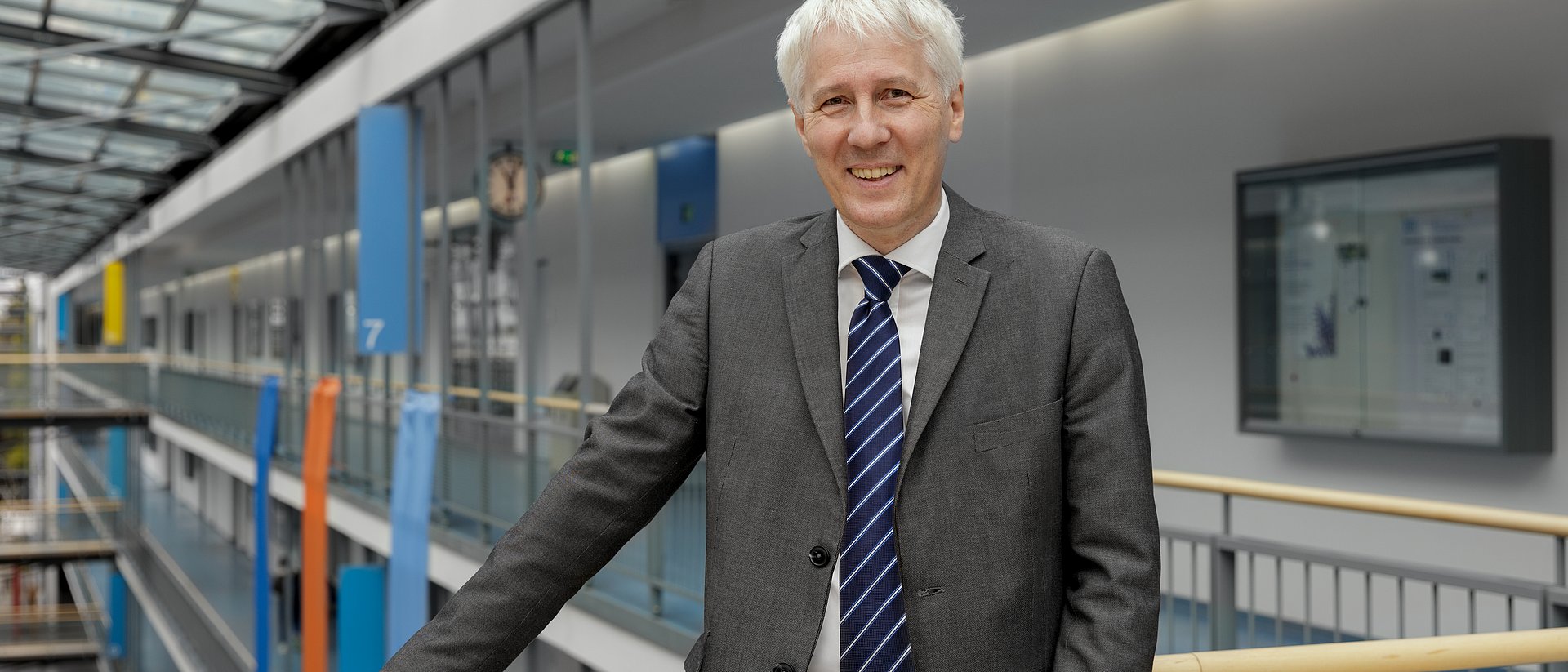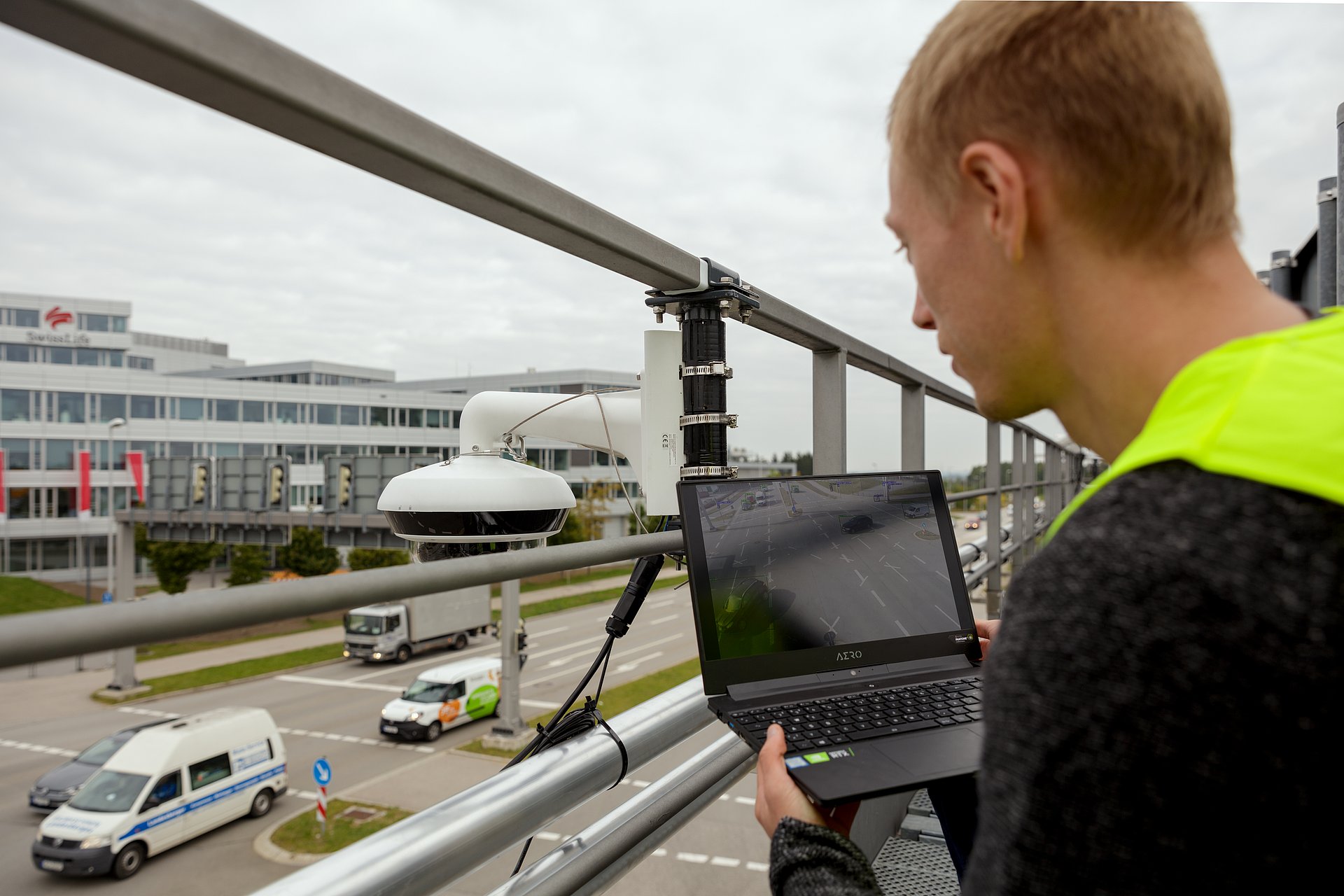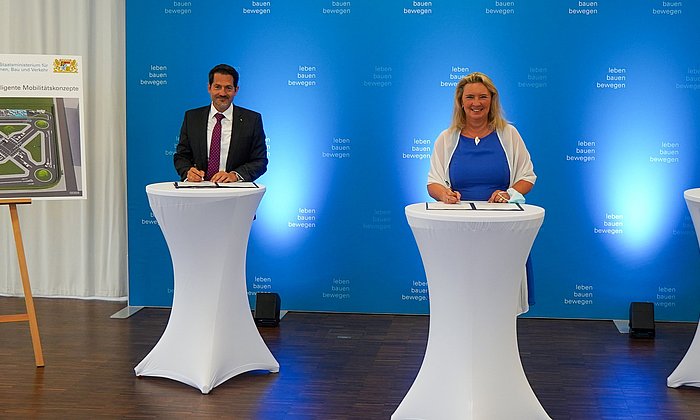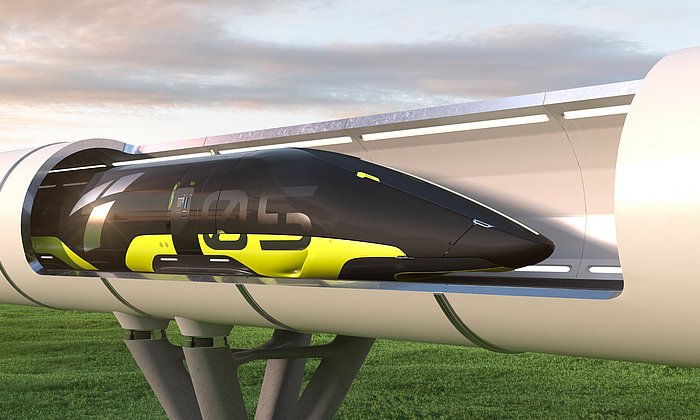Interview with Prof. Alois Knoll on the benefits of intelligent traffic systems
“The road of the future is digital”

Prof. Knoll, in the Providentia research project your team equipped a section of the A9 autobahn near Munich with radar systems and cameras. In the follow-up Providentia++ project, you’re now doing the same with a busy intersection in the district of Garching-Hochbrück. How will this work impact the traffic of tomorrow?
The sensors are positioned at a height of around 10 meters on the overhead sign bridges and masts, where they provide an excellent overview of what is happening on the road. They capture precise data on the position and speed of every traffic participant. An AI system classifies the objects and uses the data to create a digital twin – in other words a virtual model of the real traffic flow.
In case of a safety incident such as an accident or traffic jam, the information can be transmitted to every networked vehicle in real time. This makes it possible to see dangerous situations in advance and warn vehicles ahead of time. The technology can also help to improve the flow of traffic, for example by directing drivers to the lane that will move faster. Hence the name: Providentia is the Roman goddess of providence, but it is also derived from ‘proactive video-based use of telecommunications technologies in innovative automotive traffic scenarios’.
It sounds like the project offers enormous added value, even for drivers of non-autonomous vehicles.
That’s true, for example if the information from the digital twin is channeled directly via the 5G network to smartphones – which are attached to almost every windshield these days. The data could also be routed to satellite navigation systems to give drivers acoustic or virtual alerts. With stage five autonomous vehicles, the technology could even intervene directly by automatically braking or taking evasive action in a critical situation.
But what happens if there is an error and the system suddenly shuts down?
We need to distinguish between an outage in the remote control technology and malicious interference. Autonomous vehicles can and must tolerate the former. That means that they definitely must have their own intelligence to brake or stop safely when necessary. In case of malicious hacker attacks from outside the system, the vehicle should be able to check whether the incoming information actually matches up with the current traffic situation. And through the highly secure data encryption and system access points, outside intervention should not be possible anyway.
And what do you say to those who are concerned about surveillance? The system is logging and processing data from vehicles driving on the road.
Our research complies with the General Data Protection Regulation at all times. We do not record any sensitive data such as car registration numbers. And the faces of people in vehicles are never recognizable in our photos although this would be possible. Let me emphasize: The benefits we can offer through Providentia far outweigh the unlikely risks of data misuse. Every year thousands of people are killed and injured in traffic accidents in Germany. We can reduce those numbers! I am convinced: The road of the future must be digital. In that way, we will achieve greater safety, greater transparency and greater optimization and comfort.
What could the way forward to a digital road look like?
For now, TUM has recently set up a test field in Ottobrunn, just outside Munich, where we can gain new experience through direct coupling infrastructure with vehicles. However, we need to get out on the road as soon as possible. That’s the only way of learning how to operate reliable systems under real-world conditions and with real passengers. My suggestion would be to set up an autonomous shuttle between the TUM Campus in Garching and Garching-Hochbrück – and not one that creeps along at 20 km/h.
I am thinking of a shuttle that moves with the normal traffic flow. I think we need to take bold steps if our research is to have any real purpose. To achieve this, it makes sense to provide appropriate infrastructure support through safety systems such as Providentia++. After all, we want to automate as many areas of our lives as possible, above all public transportation. We can do that only with an effective digital infrastructure – as achieved on a very small scale by Providentia++ .
What do you expect from policymakers?
We should be making much bigger investments in digital mobility and implementing this vision step by step. In Munich, Germany’s traffic jam capital, I’m seeing far too little progress. Our public transportation system is overstretched, unreliable and far from up-to-date. If Munich wants to be Europe’s technology capital, then it should be possible to set up a reasonable, IT-based and intelligently controlled local transportation system with a diverse range of vehicle types, linked to individual transportation through a “city brain”. This would ensure maximum convenience and comfort with minimal energy use. It would also guarantee that a passenger could not get from A to B any faster than the way the system suggests.
How do you see the next steps?
We have reached the point with our technology where we can develop it into a real-world system. This is where the private sector needs to step in. TUM is not a manufacturer of transportation infrastructure. Next we would need state-funded projects to build large-scale sensor installations at least at key traffic nodes. In Munich the Mittlerer Ring bypass would be a possibility. It is the scene of enormous rush-hour traffic jams every day. With its ability to compute wave motions, Providentia could optimize the traffic flow.
To implement this, however, the purchasing power of cities or even the entire state would have to be pooled to bring about a structural transformation – similar to the creation of roads, railways and highways and the “car-friendly city” many years ago. With information technology we now have enormous possibilities for making our cities liveable for people again, while building entirely new industries. As you see, we have a lot of plans. But we need to act on them.

- Providentia is a research project that has been funded by the Federal Ministry of Transport and Digital Infrastructure since early 2017. Since 2020, it has been continued under the name Providentia++ with the Chair of Robotics, Artificial Intelligence and Embedded Systems at the TUM Department of Informatics serving as consortium leader. The project’s goal is to research the flow of information between vehicles and infrastructure along the A9 autobahn extending into the urban area, to create a digital twin of the current traffic situation, and to use this as a basis for developing value-added services.
- Researchers at TUM are studying autonomous driving in a number of projects. The Chair of Robotics, Artificial Intelligence and Embedded Systems is working closely with Markus Lienkamp, professor of automotive technology, Klaus Bogenberger, professor of traffic engineering, and Jörg Ott, a professor of connected mobility.
- The Technical University of Munich and the Industrieanlagen-Betriebsgesellschaft mbH put a new test bed for intelligent mobility concepts into operation in Ottobrunn, in the south of Munich, in September this year. With funding from the Bavarian Ministry of Transport, the facility will be used to explore the interaction of future autonomous transport systems and their safe and standardized operation.
- The TUM will be represented with Providentia++ at the ITS World Congress 2021 at the stand of the Federal Ministry of Transport and Intelligent Infrastructure in Hall B4, which will be held from October 11th. It takes place in Hamburg until October 14th. A miniature model of the test track, live streams and digital twins of the current traffic can be seen in real time.
- Prof. Knoll is Principal Investigator of Mobility at the Munich Institute of Robotics and Machine Intelligence (MIRMI). The research center aims to research the fundamentals of robotics, perception and artificial intelligence in order to develop technologies for the areas of health, work, mobility and the environment.
- High Resolution Images: https://mediatum.ub.tum.de/1631570
Technical University of Munich
Corporate Communications Center
- Christine Lehner
- christine.lehner@tum.de
- presse@tum.de
- Teamwebsite
Contacts to this article:
Prof. Dr. Alois Knoll
Technical University of Munich
Chair of Robotics, Artificial Intelligence and Real-time Systems
Tel: +49 (89) 289 - 18104
knoll@in.tum.de
www.tum.de


